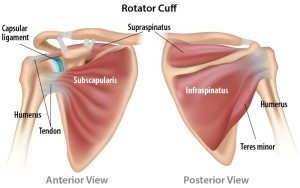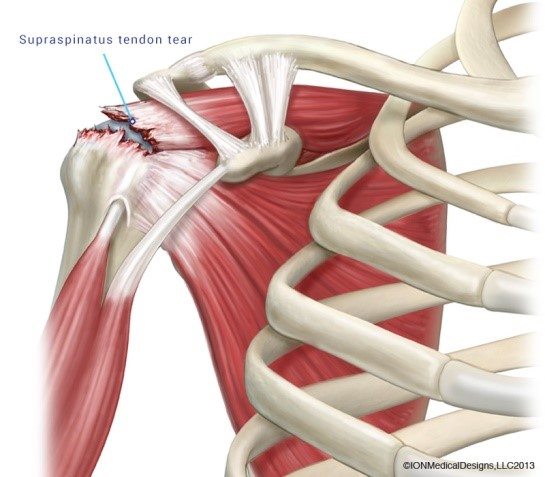What is a Rotator Cuff Strain/tear?
What is the rotator cuff?
A rotator cuff tear is a condition where there is a partial or complete tearing of one or more of the rotator cuff muscles of the shoulder. It commonly causes pain and disability in daily activities. Most tears will occur in the supraspinatus muscle and tendon, although other parts of the rotator cuff are involved too. The process will commonly begin with fraying of the tendons and eventually progressing to a tear as it is further damaged.
What is Causes Rotator Cuff damage?
A tear may be as a result from a single traumatic event such as a fall onto an outstretched arm, lifting/catching a heavy weight/object or they can develop gradually overtime due to ageing or from repeated micro-trauma from overuse. During the ageing process it is normal for the rotator cuff to become worn and degraded. It then becomes weak and prone to tearing.
The Anatomy of the Rotator Cuff
The rotator cuff is a group of four muscles: subscapularis, supraspinatus, infraspinatus and teres minor. These muscles originate on the scapula and their tendons run underneath the acromion (tip on the roof of the shoulder) where they insert onto the humerus (upper arm bone). The rotator cuff work together by lifting the arm upwards and assist in centralising the humeral head within the shoulder joint to give the shoulder increased stability. Between the rotator cuff and the acromion is a bursa, a sac filled with fluid to allow for smooth gliding movements of the rotator cuff when the arm is in motion.
These muscles originate on the scapula and their tendons run underneath the acromion (tip on the roof of the shoulder) where they insert onto the humerus (upper arm bone). The rotator cuff work together by lifting the arm upwards and assist in centralising the humeral head within the shoulder joint to give the shoulder increased stability. Between the rotator cuff and the acromion is a bursa, a sac filled with fluid to allow for smooth gliding movements of the rotator cuff when the arm is in motion.
What are the symptoms of a rotator cuff tear/strain?
The main symptoms associated with rotator cuff tears is a painful and weak shoulder. Pain is commonly felt on the outside of the shoulder with often some referral down the arm. There is difficulty performing overhead and lifting activities such as combing your hair and getting dressed. Rotator cuff tears are also associated with a loss of range of motion when attempting to lift the arm. It is quite common to experience night pain especially when lying on the affected side.
A partial rotator cuff tear may present with only mild shoulder pain and weakness with shoulder elevation. With a full thickness tear you will present with severe pain and find it extremely difficult to lift your shoulder or may not be able to at all.

How is a rotator cuff tear/strain diagnosed?
A rotator cuff tear is best diagnosed with imaging either with ultrasound (US) or magnetic resonance imaging (MRI). An MRI will be more accurate at identifying the soft tissues of the shoulder in more detail although an US is sufficient to diagnose rotator cuff tears. These imaging modalities can show the location and size of the tear. An MRI will be able to identify whether the tear is new or old as it reveals the quality of the rotator cuff muscles.
It is important to note however atraumatic, degenerative tears revealed on imaging can be associated with the patient experiencing no shoulder pain.
However, an injury to an intact cuff can lead to a traumatic tear – and these tears do require surgical repair. The sooner a repair is performed after injury, the better the outcomes for the patient.
Treatment
Acute Management 0-48 hrs
The main aim of any intervention is to reduce your pain and restore function. There are a few options available in the treatment of rotator cuff tears and with every person having different goals, your Physiotherapist will collaborate with you to determine the best course of treatment.
Most rotator cuff injuries are amenable with physiotherapy. In some cases such as full thickness tears require surgery. If conservative management with physiotherapy and/or injections has not had an improvement in pain or shoulder strength surgery may be indicated. Surgical repair of the rotator cuff involves stitching the tendon back to its attachment of the humerus. This surgery is normally performed via keyhole (arthroscope).
Rehabilitation involves settling inflammation and pain with appropriate medications, restoring full movement, normalizing scapula movement, strengthening the rotator cuff and then returning to sport and work in a controlled manner.
Atraumatic degenerative tears generally do not require surgery.
Conservative management may involve the following:
1. Painkillers and non-steroidal anti-inflammatory medications
2. Physiotherapy: restoring full shoulder range of movement, normalising scapula biomechanics, strengthening of the rotator cuff and returning to work/sport in a controlled manner
3. Cortisone steroid injections: this may be used as an adjunct to assist in reducing inflammation and controlling the pain. It is advisable to avoid repeated steroid injections in the presence of a tendon tear, as this may weaken the tendon further.
When can I return to activity
-
01
Your Physiotherapist will advise you as to when you are safe to return to sport/activity.
-
02
You can speed things up by an accurate rehabilitation program. Your Physiotherapist will provide you with exercsies and a management plan.
-
03
If you do not have a Physiotherapist download a program below and contact uswith any questions you may have?
How do I make an appointment?
Select from the page menu your closet Physica Clinic. We look forward to you attendin.
